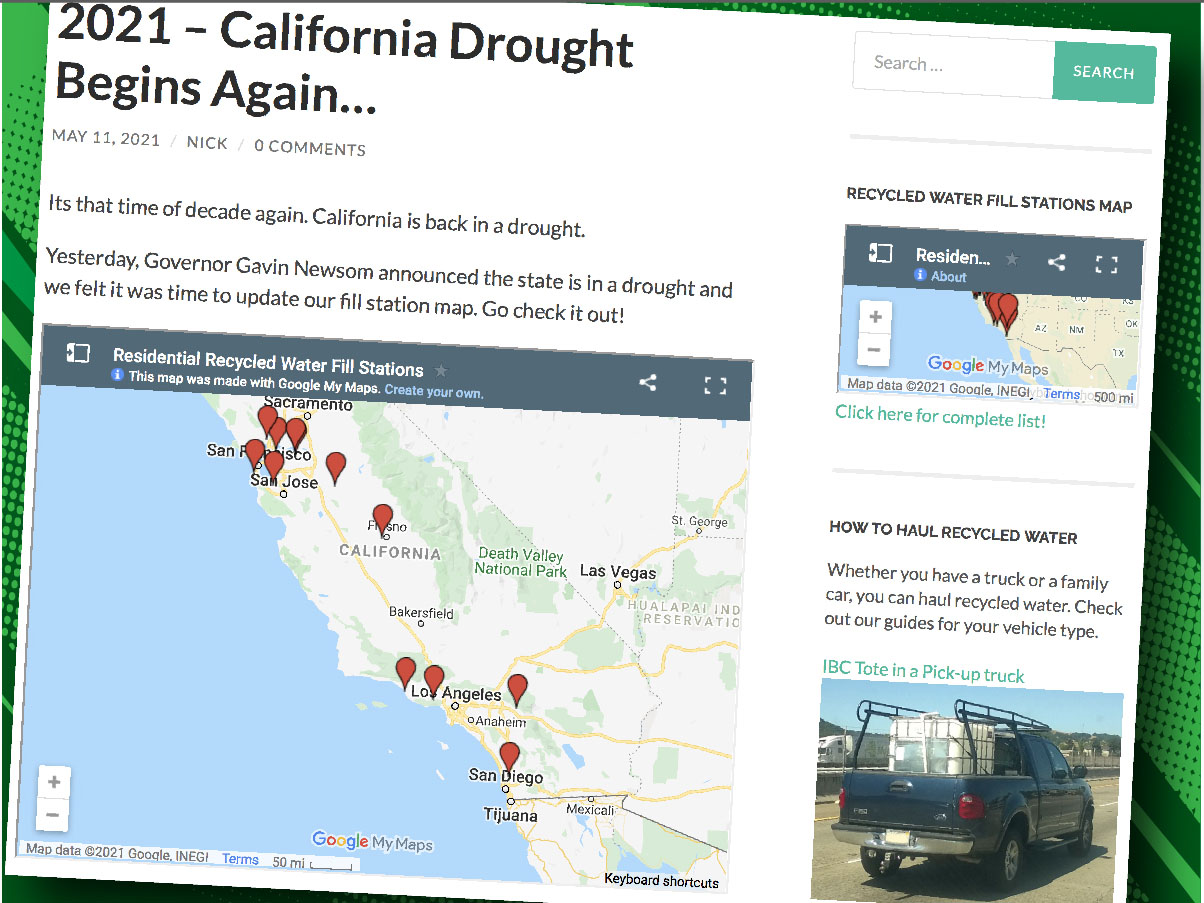
By Roni Ghelke, CWEA Clean Water
The year was 2014 and the general public was just beginning to take notice of the severity of California’s latest drought. After years of lackluster rainfall across the Golden State, reservoirs were half empty, leaving resource managers desperately seeking ways to save water. One water resource recovery facility in Dublin came up with an innovative solution to let people pick-up recycled water on their own. That it inspired CWEA member Nick Hansen to build a website all about recycled water people can haul themselves.
“Dublin San Ramon Services District’s (DSRSD) innovative solution to help combat our last drought, provided up to 300 gallons of recycled water per trip to anyone who wanted to haul it, using it strictly for landscape irrigation,” said Nick, founder of the internationally recognized blog, RecycledH2O.net. “While not economical to haul, it was the only solution until infrastructure could be built to transport it.”
Nick is a Grade 5 Certified wastewater treatment plant operator. His website features a map of all recycled water fill stations across the state, including what types of containers to use, pumps, hose connections and how to unload once home. He keeps the website updated in his spare time, while also advocating for water recycling projects around the world. The success of his blog led to international recognition from wastewater organizations in Europe and the Americas and to policymakers across the Southern Hemisphere.
When mandatory drinking water conservation restrictions went into effect in 2015, the demand for recycled water to keep landscapes alive skyrocketed. Water resource recovery facilities that offered free recycled water fill stations were packed with pickup trucks and large white totes. Suddenly this “toilet water resource” that the wastewater industry had valued for decades was being embraced by the general community.
Jump ahead to 2021, as we experience yet another drought that many believe will be the worst in a generation and demand from residents for recycled water is already going higher. At its peak demand in 2016 there were 28 agencies across California that offered recycled water, according to Nick. Today, however, that number has dwindled to just 12 recycled water fill stations, with 60 percent of them in Northern California. A quarter of those fill stations are in Contra Costa County in the East Bay, where Nick lives.
The state rates Contra Costa in the D4 or Exceptional Drought stage —the worst possible rating. The three agencies there providing a recycled water fill station include Central Contra Costa Sanitary District (Central San), Ironhouse Sanitary District, and the City of Brentwood.
“At the height of the drought in 2016, more than 20,000 people hauled water,” Nick said. “A resident of Danville saved 89 percent on his water bill by hauling recycled water.”
Between 2017 and 2020, residents slacked off on hauling recycled water to irrigate lawns, trees, plants and vegetable gardens, instead going back to the convenience of using potable water through their sprinklers. The three Contra Costa agencies saw traffic slip to just 25-30 percent of the users from the height of the 2014 drought. Even so, all three fill stations remained open.
As awareness of the severity of California’s current drought comes to the attention of the public, more people are turning to recycled water. Already this summer the three agencies have seen steadily increasing numbers.
Anticipating the demand from the recycled water community, both Brentwood and Ironhouse made changes to help simplify operations at their fill stations and increased hours of service. The City of Brentwood implemented an automated system using key cards for easier monitoring and data retention, while also allowing users 24/7 access to the fill station.
Ironhouse also increased its operation to 12 hours every day and made infrastructure changes that now provide the fill station with a continuous feed directly from the District’s Recycled Water Facility.In addition to its District customers, Ironhouse makes its recycled water available for a nominal fee to residents of nearby Antioch, Pittsburg and Knightsen, who do not otherwise have access to recycled water.
Central San covers the largest region in Contra Costa County, including 14 cities and unincorporated portions of the central county. Unlike 2015 and 2016 when county residents were under tight restrictions on water use, the county so far this year has only asked for voluntary reductions.
Some Central San customers aren’t waiting for mandatory cuts and are instead choosing to haul recycled water up to 25 miles by freeway to help conserve water.
Despite the extra time and expense of hauling recycled water from the fill stations to their homes, for some collecting water is a daily ritual.
Nick’s website provides all of the information Californians need to start hauling recycled water on their own. It’s based on his years of trial and error hauling water to keep his own garden green.
When in “drought,” be like Nick—be a recycled water hero and share your wastewater pro knowledge.